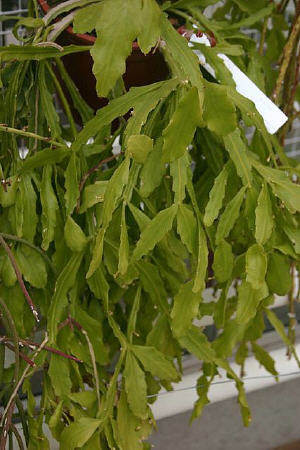See Calvente
thesis 2010
6. RHIPSALIS GOEBELIANA Backeb., Descr. Cact. Nov. 1: 10. 1957.
TYPE: Backeberg, Cactaceae 2: 676, Abb. 633. 1959 (neotype in Barthlott and
Taylor 1995); ex. hort. Botanischer Garten Bonn no. 4467 (epitype in
Bauer 2008: ZSS28438).
Habitat unknown, ca. 30 cm long (cultivated), branching apical or sub-apical, rare lateral.
Stem segments flattened to trialate in longitudinal section, 1 -2 mm diam, pale olive green, succulent, monomorphic, 10.4-13.9 cm long, base attenuate, apex truncate or rounded; wings 2(-3), 0.7-1.5 cm wide, margin serrate, slightly lobed or dentate, plane, with 3-4 mm projections, midrib 1.5-3.4 mm diam, cylindric. Areoles between or on margin projections, 1-2.5 cm apart, first of segment 0.5-4 cm from segment base; when sterile 1.5-2.5 mm diam, glabrous; when fertile 1.5-2.5 diam, with scarce hairs at margin, 1-2 acicular scales, 1 flower/fruit. Flowers ca. 8.5 mm diam; pericarpel 3 X 2.3 mm, cylindric, greenish, glabrous; with 2-3 sepaloid tepals, 0.4-1.5 mm long and 7 petaloid tepals, 2.5-6 X 2-2.5 mm, wide elliptic or elliptic, patent to sub-erect, pinkish green, apex rounded, slightly cucullate, margin straight. Style ca. 3 mm long; stigma with 4 lobes, 1.5 mm long, ligulate, spreading. Ovules in 3 incomplete septa, funicle short (< 0.5 mm long). Stamens ca. 35, 3.5-5 mm long, internal shorter, facing inwards, white. Nectary ca. 0.4 mm long. Fruit 4.5-5 X 4.7-5 mm, globoid, greenish white, glabrous. Figure 6: D, H.
Notes: Backeberg (1959) described R. goebeliana based on a cultivated specimen of unknown provenance. R. goebeliana resembles forms of R. cuneata and R. oblonga however, the pale live-green stems with serrate, slightly lobed or dentate margins are sufficient to recognize it as a separate taxon. Furthermore, the recent molecular phylogeny of Rhipsalis (Calvente et al.
in prep) indicates that this species is not linked to R. cuneata nor to R. oblonga (Fig 1). Therefore, to avoid confusion with Brazilian and Andean species the circumscription here applied only includes the cultivated specimens.
Habitat and distribution: This species is only known from cultivated material.
6. RHIPSALIS GOEBELIANA Backeb., Descr. Cact. Nov. 1: 10. 1957.
TYPE: Backeberg, Cactaceae 2: 676, Abb. 633. 1959 (neotype in Barthlott and
Taylor 1995); ex. hort. Botanischer Garten Bonn no. 4467 (epitype in
Bauer 2008: ZSS28438).
Habitat unknown, ca. 30 cm long (cultivated), branching apical or sub-apical, rare lateral.
Stem segments flattened to trialate in longitudinal section, 1 -2 mm diam, pale olive green, succulent, monomorphic, 10.4-13.9 cm long, base attenuate, apex truncate or rounded; wings 2(-3), 0.7-1.5 cm wide, margin serrate, slightly lobed or dentate, plane, with 3-4 mm projections, midrib 1.5-3.4 mm diam, cylindric. Areoles between or on margin projections, 1-2.5 cm apart, first of segment 0.5-4 cm from segment base; when sterile 1.5-2.5 mm diam, glabrous; when fertile 1.5-2.5 diam, with scarce hairs at margin, 1-2 acicular scales, 1 flower/fruit. Flowers ca. 8.5 mm diam; pericarpel 3 X 2.3 mm, cylindric, greenish, glabrous; with 2-3 sepaloid tepals, 0.4-1.5 mm long and 7 petaloid tepals, 2.5-6 X 2-2.5 mm, wide elliptic or elliptic, patent to sub-erect, pinkish green, apex rounded, slightly cucullate, margin straight. Style ca. 3 mm long; stigma with 4 lobes, 1.5 mm long, ligulate, spreading. Ovules in 3 incomplete septa, funicle short (< 0.5 mm long). Stamens ca. 35, 3.5-5 mm long, internal shorter, facing inwards, white. Nectary ca. 0.4 mm long. Fruit 4.5-5 X 4.7-5 mm, globoid, greenish white, glabrous. Figure 6: D, H.
Notes: Backeberg (1959) described R. goebeliana based on a cultivated specimen of unknown provenance. R. goebeliana resembles forms of R. cuneata and R. oblonga however, the pale live-green stems with serrate, slightly lobed or dentate margins are sufficient to recognize it as a separate taxon. Furthermore, the recent molecular phylogeny of Rhipsalis (Calvente et al.
in prep) indicates that this species is not linked to R. cuneata nor to R. oblonga (Fig 1). Therefore, to avoid confusion with Brazilian and Andean species the circumscription here applied only includes the cultivated specimens.
Habitat and distribution: This species is only known from cultivated material.
R. goebeliana Backeberg Descr. Cact. nov. [1]; 10 (1956 publ. 1957)
 |
Very similar to the Brazilian R. oblonga (q.v.) and flat-stemmed forms of the Andean R. micrantha Kunth f. micrantha. |
R. goebeliana (copyright KAF, Kew 2006)